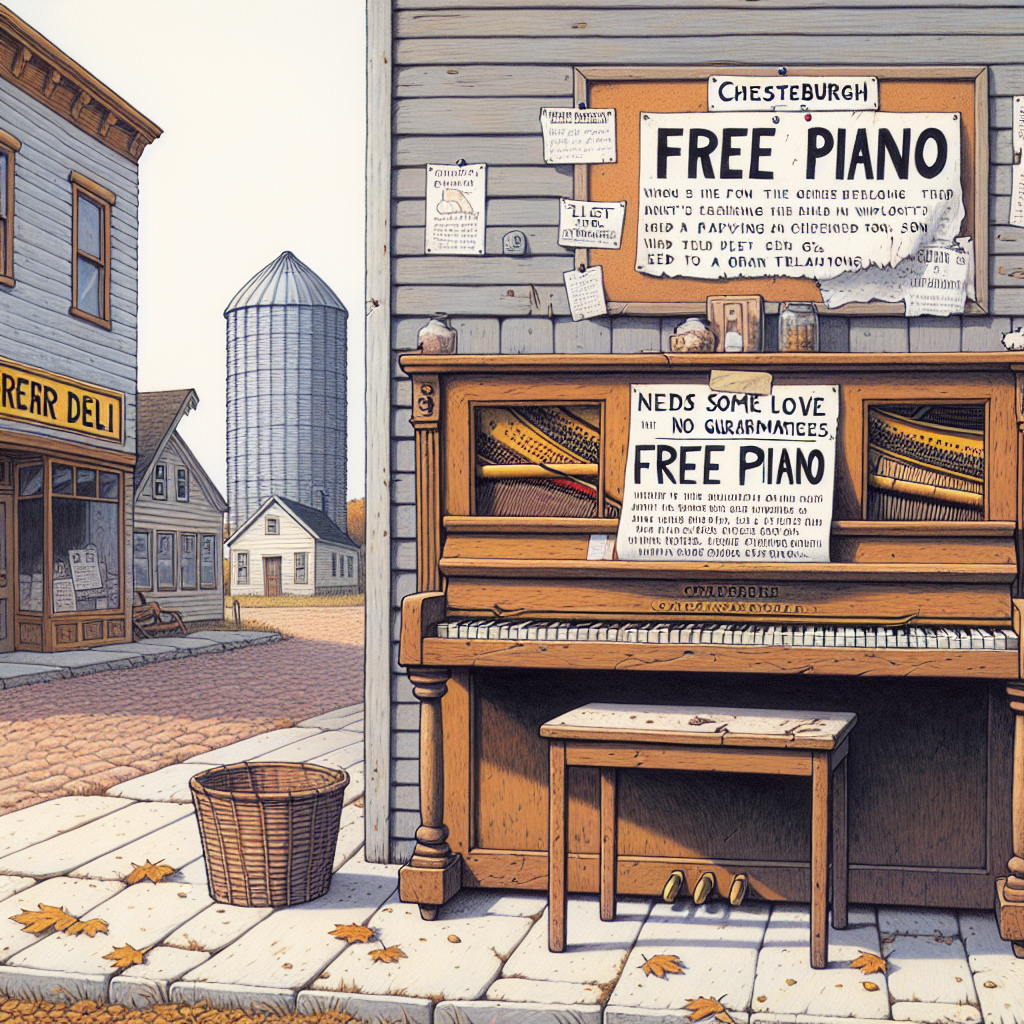**The Curious Case of Chesterburgh’s Cardboard Billboard: The Piano That Played Itself**

The air was thick with a certain kind of restless expectancy in Chesterburgh this past week, a mood you’d usually only find brewing in the lead-up to the annual Pumpkin Festival or the town council’s controversial debate over the color of the library’s new shutters. But no — this time, it wasn’t pumpkins, politics, or painted wood igniting the buzz. Instead, the source of our collective curiosity was, of all things, a single piece of cardboard.
It appeared overnight, taped with evident haste to the weathered bulletin board outside Maggie’s Deli, right next to the faded flyer for last month’s lost cat (still missing, by the way). “FREE PIANO,” it proclaimed in block letters that looked like they’d been carefully scrawled by someone more accustomed to honing calligraphy than punchlines. Underneath, smaller, more tentative script added: “Needs some love. No guarantees.”
In a town like Chesterburgh, where the tallest skyscraper is the grain silo and word of mouth functions as an unofficial municipal notice system, this unexpected offering of a piano was akin to spotting a unicorn wearing a top hat and delivering the morning paper. People stopped in their tracks, phones raised, selfies snapped — not so much with the instrument itself, a battered upright that squatted like an ancient relic outside the deli entrance, but with the poster as much as anything else.
Naturally, the piano quickly acquired nicknames. The “Deli Steinway,” for its dubious grandeur. The “Melancholy Keys,” for the peeling veneer and stubbornly out-of-tune strings that rewrote every song into a minor tragedy. And the “Cardboard Billboard,” in homage to the impromptu ad that had turned a silent piece of furniture into Chesterburgh’s hottest item. You’d be forgiven, on a casual stroll past the deli, for imagining the entire town might throw its collective hat into the ring just to see who’d claim the prize.
Yet, who left the piano there, and why, was a question that went unanswered no matter how many rounds of speculation fueled local coffee shop debates. Was it Mrs. Delaney’s long-lost hope to inspire a second career as a jazz player after retirement? Or Mr. O’Connell’s cryptic farewell gift, absent any note beyond the cardboard invitation? Or perhaps some midlife crisis disguised as a neighborhood goodwill gesture? Theories proliferated, as they tend to do in Chesterburgh, where the truth is often less interesting than the story you tell about it.
Complicating matters further was the piano’s decidedly precarious position on the slightly uneven patch of sidewalk by Maggie’s. It leaned just enough to make passersby hold their breath, half-expecting it to take an unexpected tumble with all the grace of a gravid cat. Beneath it, a scattering of fallen autumn leaves seemed to settle in for a long wait, framing the scene like some quixotic still-life.
Things took a turn from charmingly odd to downright peculiar when, two days after the piano’s arrival, a series of odd music notes began to emanate from it at unpredictable hours. Not full performances — no, that would have made things manageable — but brief bursts of discordant tinkling. Witnesses reported hearing a stray tune, a few bars of Chopin, or even sporadic jazz riffs between the dulcet tones of the ice cream van’s passing jingle. No figure was ever seen at the keys.
This phenomenon sparked a surge of new theories. Some locals swore the piano was possessed — or at the very least haunted — by Chesterburgh’s long-forgotten maestro, old Mr. Grimes, whose ghostly fingertips once serenaded this same stretch of Main Street during the town’s heyday. Others optimistically attributed the sounds to a mechanical malfunction, imagining miniature robots trapped inside, struggling to keep rhythm.
I, of course, took a different approach. Having spent far too many hours behind my camera lens to believe in ghosts or malfunctioning mus
